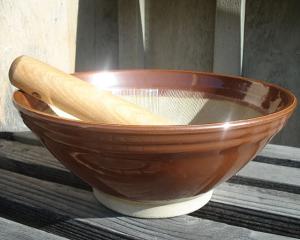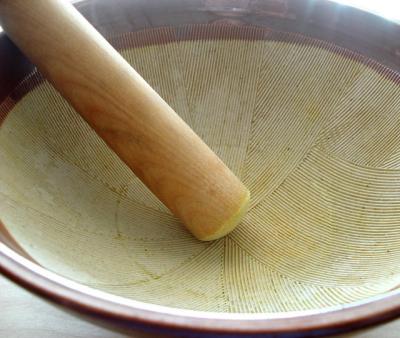Suribachi, Japanese grinding bowl or mortar
 When I wrote about essential Japanese cooking equipment a while back, I forgot to mention one item that I use quite often, a suribachi. A suribachi is a sturdy ceramic bowl that's used with a grinding stick called a surikogi like a mortar and pestle. While I'm a big fan of handy electric equipment like food processors for many tasks, sometimes the results you get by doing things by hand are well worth the elbow grease needed.
When I wrote about essential Japanese cooking equipment a while back, I forgot to mention one item that I use quite often, a suribachi. A suribachi is a sturdy ceramic bowl that's used with a grinding stick called a surikogi like a mortar and pestle. While I'm a big fan of handy electric equipment like food processors for many tasks, sometimes the results you get by doing things by hand are well worth the elbow grease needed.
What makes the suribachi unique, and I think better than a regular mortar, is that the inside is unglazed and grooved, as you can see from the photo below (click on it to see it larger):
The rough-surfaced grooves, which are called kushi no me since they are made with a comb-like device on the wet surface of the clay, help to mash and bruise whatever you are grinding a lot more efficiently than a smooth surface. It's ideal for grinding up sesame seeds, which is what I use it for mostly.
It's also great for making things like peanut sauce - though I do pre-chop the peanuts in the food processor to make things easier. The final grinding in the suribachi seems to really bring out the oils in the nuts, making them so fragrant.
It can be used for grinding up spices too. (My surikogi is stained a bit yellow because I was using it for grinding up some curry spices recently.) The rough grooved surface can also be used for grating soft vegetables like potatoes, wasabi or horseradish root. (Harder and stringier vegetables like carrot and ginger don't grate so well.)
If you do buy a suribachi, try to get the biggest one you can store comfortably in your kitchen. It's much more comfortable to grind up even a small amount in a large bowl. Mine is about 25cm / about 10 inches in diameter. You may see small 'mini suribachi' - these are pretty useless really, though they can make nice individual graters for things like grating fresh wasabi root on the spot. The minimum size for a usable suribachi is around 18cm, or 7 inches.
The first place to look for a suribachi is, as with all Japanese cooking supplies, your local Japanese food store. If you can't find one, I've spotted some on eBay here (a cobalt blue one) and here (a classic brown one). It's also sold on Amazon.com. (None of those merchants ship outside of the U.S. unfortunately.)
See how to grind up sesame seeds to make a paste/sauce in this recipe.
If you enjoyed this article, please consider becoming my patron via Patreon. ^_^


 Welcome to Just Hungry, where we serve authentic Japanese recipes and more! I'm
Welcome to Just Hungry, where we serve authentic Japanese recipes and more! I'm 












Comments
anon.
22 September, 2008 - 23:33
Permalink
thanks
thanks
Scyrene
17 January, 2010 - 01:35
Permalink
Re: Suribachi, Japanese grinding bowl or mortar
I can't believe it! I found one of these in our house a few months ago - and just assumed it was a useless ornamental bowl (the unglazed interior certainly precluded using it to serve anything wet). But now I know! I hope it didn't take it to a charity shop...
anon.
6 July, 2010 - 19:26
Permalink
Re: Suribachi, Japanese grinding bowl or mortar
I don't agree with advice to get the largest one available. When I was in Japan several years ago, a shop carried suribachis from about 3-1/2 inches up to 10 or more inches (as you know, they don't use inch measurements). I bought one of the 3-1/2 inch and one about 4-1/2 inches. I use the small one nearly every day for my homemade salad dressing. I grind garlic, herbs and mustard together, then make a paste with about 1 Tbs oil to infuse the flavors before blending in about 3 Tbs seasoned rice vinegar. This amount is just right for enough salad for the wife and me. And by the way, the 3 to 1 vinegar to oil ratio is correct; rice vinegar is considerably milder that most, and don't add the vinegar first, the oil infuses the flavors better. When making salad for 4 to 8, I use the suribachi that's about 4-1/2 inches dia.(it has the number "4" stamped on the bottom along with some Japanese characters). These two fit in an implement drawer with their surikogis(pestles), my kitchen scissors, silicone spatulas, instant thermometers, etc. The Japanese hand carved wooden surikogis are works of art in themselves. The machine made ones mostly available in the U.S. are rather dull by comparison.
I have a large suribchi bought from a Japanese market in California, but hardly ever have use for it, and I have to store it in a cabinet with other bowls.
Robert.
22 September, 2010 - 11:15
Permalink
Re: Suribachi, Japanese grinding bowl or mortar
I want to make mochi-rice-cake, and i need a special mortar.
I have a suribatchi at home, but they are in ceramic.
For hard pounding on sweet rice this is not so a good tool, because it will break. How they do it in Japan ?
maki
22 September, 2010 - 13:05
Permalink
Re: Suribachi, Japanese grinding bowl or mortar
Mochi cakes are traditionally not made with powder, but from cooked/steamed rice that is then pounded into a dough or paste. Traditionally it was made in a huge wooden mortar, pounded with a wooden hammer like thing, and was a two-person operation. This is called mochitsuki. Here's a video of a mochitsuki event. Several Japanese expat/immigrant communities around the world hold mochitsuki events, especially around New Year's.
Most mochi nowadays is made in a special machine which is rather like a bread machine (the mochi machine came first actually - the bread machine idea came from that). If you have a food processor with a strong motor, you could attempt to make mochi in that.
If you want to make your own mochi powder you will need to cook the rice, let it dry out, then grind it into a powder. That's how commercial mochi powder is made. You could try using a suribachi to grind the rice (once it's cooked and dried it's a lot easier) but it's a ton of work.
James
2 December, 2010 - 20:15
Permalink
Re: Suribachi, Japanese grinding bowl or mortar
They beat it with a large wooden mallot the length of an axe in a big marble bowl. But you have to cook it in a fire cooker and use Mochi rice.
maki
3 December, 2010 - 01:54
Permalink
Re: Suribachi, Japanese grinding bowl or mortar
As I explained in the previous message, an usu (the thing mochi is pounded in) is a big wooden bowl made out of a hollowed out chunk of wood or a tree trunk, basically, not marble.
anon.
24 October, 2011 - 06:10
Permalink
Re: Suribachi, Japanese grinding bowl or mortar
Thanks for the great info!
I picked up mine (7") for 25 cents in a local flea market here in San Francisco Bay Area. Amazing deal! :-D
KenG
12 August, 2012 - 19:02
Permalink
Re: Suribachi, Japanese grinding bowl or mortar
I use one all the time for grinding small amounts of whole spices.
Much less messy than an electric mini-grider.